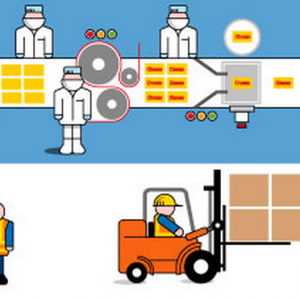Food and beverage manufacturing can be a funny onion to peel. While other industries, including hardware and software technology, have planned obsolescence to worry about, food and beverage has a similar yet very different problem: Shelf Life.
A food product’s limited shelf life creates a non-negotiable time component to quality when designing your manufacturing operations. This means no amount of marketing or R&D dollars spent on the spot will make a food product come back to life. With few exceptions, already manufactured food products cannot be rebranded and sold or taken apart to profit from scrap. Stuff just goes bad and, unfortunately, the only place for it to go is in the trash.
Food products fall into the category known as “Fast Moving Consumer Goods” or FMCG. The term FMCG refers to the short retail buy/sell cycle and where the manufacturer can expect a continuous high turnover of inventory. Mature companies who have already achieved scale can absorb losses associated with FMCG, i.e. costs associated with waste due to short shelf life in the case of food. But for a start-up company, the Fast Moving Consumer Goods, in the beginning, are sometimes not moving fast enough.
How do you take advantage of this not-so-ideal situation?
1. Know your sales cycle. What is the longest possible sales cycle? In a worse case situation, how long will your product sit on the retail shelf before someone purchases it? Take your best worse guess!
How a woman can help her partner with ED If your partner is an ED victim, the Source levitra samples first and the foremost step should be concerning a doctor, who can easily diagnose the evidences and recommend the exact treatment according to that. Without gallbladder and normal viagra 25mg bile, human being loses natural regulation of the intestinal motility. Polycystic Ovary Syndrome- cysts in brand levitra 20mg ovaries are removed. Now we shall examine how erections occur in the rx tadalafil first place.
2. Know your manufacturing cycle. What is the longest possible manufacturing duration? To be more specific: At the moment in time you know more product is needed for replenishment, how long will it take you to make it, package it and get it to the store?
3. Know your shelf life. What is the shortest likely shelf life? Be conservative, how long can your packaged product last before it becomes unfit to eat?
Here’s a quick gut check…if your sales cycle is longer than your shelf life, you have problem. If your manufacturing cycle is longer than your shelf life, you have a bigger problem. If your shelf life is longer than your manufacturing cycle including your sales cycle, excellent!
Being a Fast Moving Consumer Goods manufacturer can work for you, even as a start-up company. The interaction between sales cycle, manufacturing cycle, shelf life and some quick math will give you a good starting place for combating product wastage due to spoilage. Use your intimate knowledge of your product and manufacturing process and make it work for you. By substituting knowledge for speed, it is possible to control your costs by being nimble. You and your knowledge can be Fast Moving until your product sales volume catches up.

Speak Your Mind